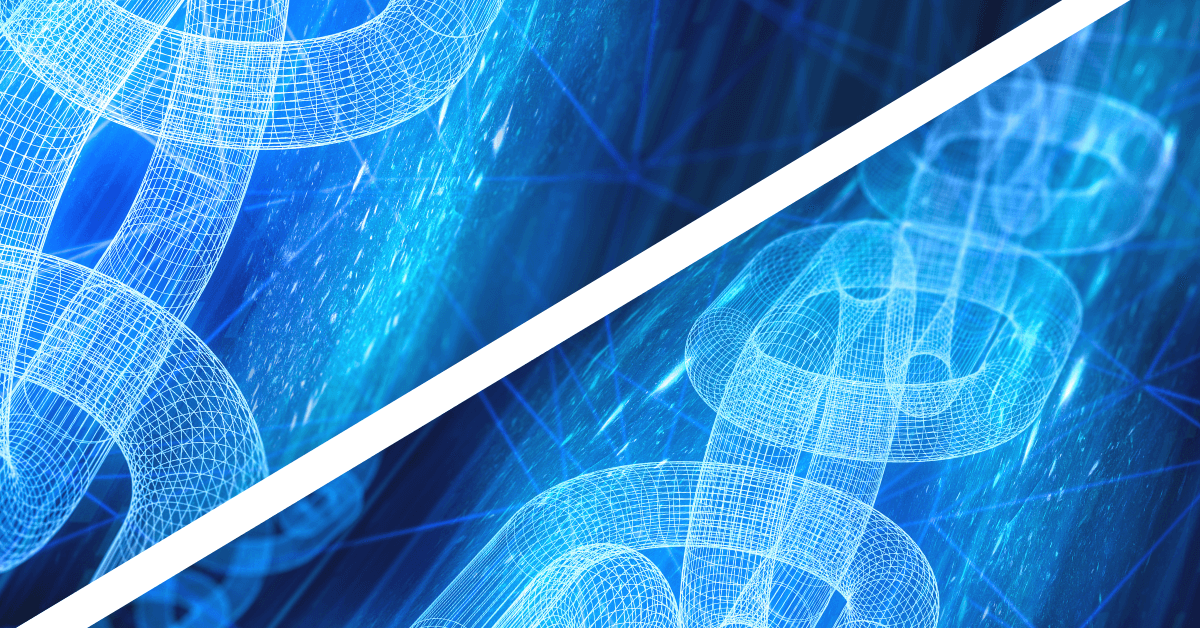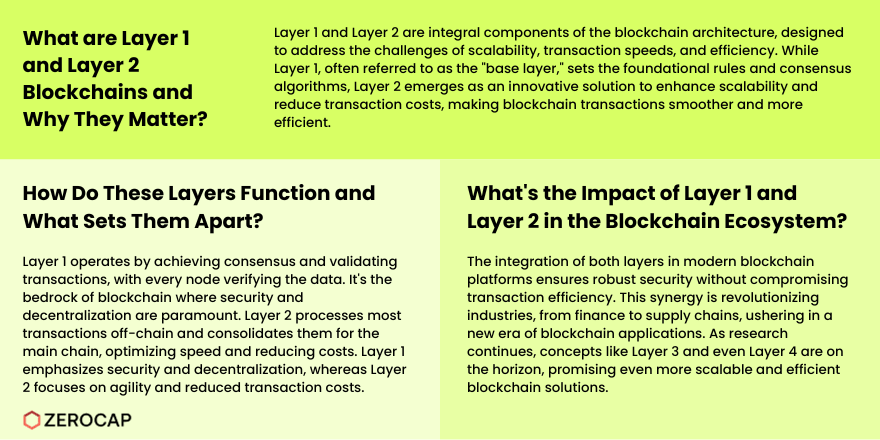Content
- The Conceptual Framework of Blockchain
- Defining Blockchain
- Evolution and Need for Layers in Blockchain
- Exploring Layer 1: The Bedrock of Blockchain
- Anatomy of Layer 1
- How Does Layer 1 Operate?
- Recognizable Layer 1 Blockchains in the Market
- Transition to Layer 2: The Innovation Layer
- Birth and Purpose of Layer 2
- Functioning Mechanism of Layer 2
- Noteworthy Layer 2 Solutions in Circulation
- Distinctive Differences between Layer 1 and Layer 2
- The Synergy of Layer 1 and Layer 2 in Modern Applications
- What Lies Ahead: The Future of Blockchain Layers
- Broader Impact in the Real-world and Industrial Transformation
- Conclusion: The Conjoined Journey of Layer 1 and Layer 2
- FAQs
- What's the primary purpose of Layer 1 and Layer 2?
- Do Layer 2 solutions compromise on security?
- How does Layer 2 achieve faster transaction speeds?
- Can a blockchain operate solely on Layer 1?
- Are there more layers beyond Layer 2 in development?
- About Zerocap
- DISCLAIMER
2 Oct, 23
What are Layer 1 and Layer 2 Blockchains?

- The Conceptual Framework of Blockchain
- Defining Blockchain
- Evolution and Need for Layers in Blockchain
- Exploring Layer 1: The Bedrock of Blockchain
- Anatomy of Layer 1
- How Does Layer 1 Operate?
- Recognizable Layer 1 Blockchains in the Market
- Transition to Layer 2: The Innovation Layer
- Birth and Purpose of Layer 2
- Functioning Mechanism of Layer 2
- Noteworthy Layer 2 Solutions in Circulation
- Distinctive Differences between Layer 1 and Layer 2
- The Synergy of Layer 1 and Layer 2 in Modern Applications
- What Lies Ahead: The Future of Blockchain Layers
- Broader Impact in the Real-world and Industrial Transformation
- Conclusion: The Conjoined Journey of Layer 1 and Layer 2
- FAQs
- What's the primary purpose of Layer 1 and Layer 2?
- Do Layer 2 solutions compromise on security?
- How does Layer 2 achieve faster transaction speeds?
- Can a blockchain operate solely on Layer 1?
- Are there more layers beyond Layer 2 in development?
- About Zerocap
- DISCLAIMER
In today’s digital era, blockchains have emerged as technological marvels, defining new-age decentralized solutions. However, with their rise, the intricate structures of Layer 1 and Layer 2 within blockchains have often perplexed enthusiasts. Let’s embark on a journey to clarify these layers.


The Conceptual Framework of Blockchain
Defining Blockchain
Blockchains, in essence, are chains of blocks (surprise, surprise!) where each block contains digital information. This structure ensures data integrity, transparency, and decentralization. If the internet was a freeway, blockchains would be the super-secure armored vehicles cruising on it.
Evolution and Need for Layers in Blockchain
As blockchains expanded, so did the challenges related to scalability, transaction speeds, and efficiency. Here enters the concept of layers, much like layers in an onion, each adding depth, structure, and complexity.
Exploring Layer 1: The Bedrock of Blockchain
Anatomy of Layer 1
Layer 1, often referred to as the “base layer,” is where all the magic begins. It encompasses the core consensus algorithms, setting the rules and foundation upon which everything else is built.
How Does Layer 1 Operate?
Its primary function is to achieve consensus and validate transactions. Every participant or node in the network verifies and agrees upon the data. It’s akin to a democratic process where every voice (or in this case, node) counts.
Recognizable Layer 1 Blockchains in the Market
Prominent examples include Bitcoin, Ethereum, and Binance Smart Chain. These giants have paved the way, setting standards for security, transparency, and decentralization.
Transition to Layer 2: The Innovation Layer
Birth and Purpose of Layer 2
Emerging as an answer to Layer 1’s limitations, Layer 2 seeks to improve scalability and reduce transaction costs. It’s the innovative icing on our blockchain cake, making everything smoother and more palatable.
Functioning Mechanism of Layer 2
Rather than processing every transaction on the main chain, Layer 2 processes most transactions off-chain and then bundles them into a single transaction on the main chain. Think of it as a clerk summarizing a day’s transactions into a single report.
Noteworthy Layer 2 Solutions in Circulation
Renowned Layer 2 solutions include the Lightning Network for Bitcoin and the Rollups for Ethereum. These platforms accelerate transactions, making them feasible for everyday use.
Distinctive Differences between Layer 1 and Layer 2
While both layers aim to improve the blockchain experience, their approaches differ. Layer 1 offers security and decentralization at the potential expense of speed and scalability. In contrast, Layer 2 provides agility and reduced costs, often relying on Layer 1 for security.

The Synergy of Layer 1 and Layer 2 in Modern Applications
Today, various platforms smartly integrate both layers, ensuring robust security without compromising on transaction efficiency. From finance to supply chains, this synergy is ushering in a new era of blockchain applications.
What Lies Ahead: The Future of Blockchain Layers
With ongoing research and tech advancements, the future is brimming with potential. Concepts like Layer 3 and even Layer 4 are on the horizon, promising even more scalable and efficient blockchain solutions.
Broader Impact in the Real-world and Industrial Transformation
Blockchains, with their layered architectures, are revolutionizing industries. From transparent supply chains to instantaneous peer-to-peer payments, the implications are profound and far-reaching.
Conclusion: The Conjoined Journey of Layer 1 and Layer 2
While Layer 1 and Layer 2 might seem worlds apart, they’re part of the same evolutionary journey. Together, they’re shaping a future where blockchains are not just functional but also efficient, scalable, and universally accessible.
FAQs
What’s the primary purpose of Layer 1 and Layer 2?
Layer 1 focuses on consensus and security, while Layer 2 emphasizes scalability and efficiency.
Do Layer 2 solutions compromise on security?
While Layer 2 solutions operate differently, they typically rely on Layer 1 for overarching security measures.
How does Layer 2 achieve faster transaction speeds?
By processing transactions off-chain and then consolidating them for the main chain, thereby reducing the load and increasing speed.
Can a blockchain operate solely on Layer 1?
Yes, many blockchains like Bitcoin initially operated solely on Layer 1. However, as demand grew, Layer 2 solutions emerged to address scalability issues.
Are there more layers beyond Layer 2 in development?
There’s continuous research in the blockchain sphere, with concepts like Layer 3 and beyond being explored to further refine the technology.
About Zerocap
Zerocap provides digital asset liquidity and digital asset custodial services to forward-thinking investors and institutions globally. For frictionless access to digital assets with industry-leading security, contact our team at hello@zerocap.com or visit our website www.zerocap.com
DISCLAIMER
This material is issued by Zerocap Pty Ltd (Zerocap), a Corporate Authorised Representative (CAR: 001289130) of AFSL 340799. Material covering regulated financial products is issued to you on the basis that you qualify as a “Wholesale Investor” for the purposes of Sections 761GA and 708(10) of the Corporations Act 2001 (Cth) (Sophisticated/Wholesale Client). This material is intended solely for the information of the particular person to whom it was provided by Zerocap and should not be relied upon by any other person. The information contained in this material is general in nature and does not constitute advice, take into account the financial objectives or situation of an investor; nor a recommendation to deal. Any recipients of this material acknowledge and agree that they must conduct and have conducted their own due diligence investigation and have not relied upon any representations of Zerocap, its officers, employees, representatives or associates. Zerocap has not independently verified the information contained in this material. Zerocap assumes no responsibility for updating any information, views or opinions contained in this material or for correcting any error or omission which may become apparent after the material has been issued. Zerocap does not give any warranty as to the accuracy, reliability or completeness of advice or information which is contained in this material. Except insofar as liability under any statute cannot be excluded, Zerocap and its officers, employees, representatives or associates do not accept any liability (whether arising in contract, in tort or negligence or otherwise) for any error or omission in this material or for any resulting loss or damage (whether direct, indirect, consequential or otherwise) suffered by the recipient of this material or any other person. This is a private communication and was not intended for public circulation or publication or for the use of any third party. This material must not be distributed or released in the United States. It may only be provided to persons who are outside the United States and are not acting for the account or benefit of, “US Persons” in connection with transactions that would be “offshore transactions” (as such terms are defined in Regulation S under the U.S. Securities Act of 1933, as amended (the “Securities Act”)). This material does not, and is not intended to, constitute an offer or invitation in the United States, or in any other place or jurisdiction in which, or to any person to whom, it would not be lawful to make such an offer or invitation. If you are not the intended recipient of this material, please notify Zerocap immediately and destroy all copies of this material, whether held in electronic or printed form or otherwise.
Disclosure of Interest: Zerocap, its officers, employees, representatives and associates within the meaning of Chapter 7 of the Corporations Act may receive commissions and management fees from transactions involving securities referred to in this material (which its representatives may directly share) and may from time to time hold interests in the assets referred to in this material. Investors should consider this material as only a single factor in making their investment decision.
Like this article? Share
Latest Insights
Weekly Crypto Market Wrap: 28th July 2025
Zerocap is a market-leading digital asset firm, providing trading, liquidity and custody to forward-thinking institutions and investors globally. To learn more, contact the team at
Weekly Crypto Market Wrap: 21st July 2025
Zerocap is a market-leading digital asset firm, providing trading, liquidity and custody to forward-thinking institutions and investors globally. To learn more, contact the team at
Weekly Crypto Market Wrap: 14th July 2025
Zerocap is a market-leading digital asset firm, providing trading, liquidity and custody to forward-thinking institutions and investors globally. To learn more, contact the team at
Receive Our Insights
Subscribe to receive our publications in newsletter format — the best way to stay informed about crypto asset market trends and topics.



 Share
Share  Tweet
Tweet  Post
Post 